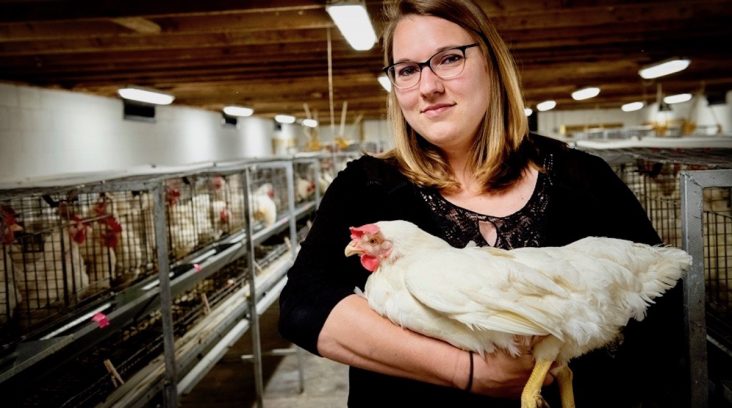UA scientist working on project to develop more water-efficient chickens
by June 1, 2022 12:24 pm 1,189 views

Sara Orlowski, assistant professor of poultry science, is selecting broilers for water efficiency. (photo from Fred Miller, project/program specialist, University of Arkansas Agricultural Communication Services)
Access to fresh water will be a significant issue for many global farmers. Chickens are the most widely grown livestock animal, and Sara Orlowski, assistant professor of poultry science at the University of Arkansas, is trying to develop chicken breeds that use less water.
Her research is part of a five-year, multi-institution project funded by a $9.9 million U.S. Department of Agriculture National Institute of Food and Agriculture grant. The grant was awarded through NIFA’s Agriculture and Food Research Initiative. Walter Bottje, professor of poultry science for the Arkansas Agricultural Experiment Station, the research arm of the University of Arkansas System Division of Agriculture, is the project director.
The project, “Empowering the U.S. Broiler Industry for Transformation and Sustainability,” partners the UA System Division of Agriculture with Cornell University and brings together diverse research expertise from at least five other university systems to improve efficiency of nutrient and water use in the U.S. poultry industry.
Orlowski has appointments to both the Agricultural Experiment Station and the Arkansas Cooperative Extension Service. Her project is also supported by a grant from Cobb-Vantress, Inc., a Siloam Springs-based primary broiler breeder company.
According to the United Nations, about 4 billion people, roughly two-thirds of the world’s population, experience a scarcity of fresh water for at least one month each year. The strain on safe water will increase as the population reaches an estimated 9.7 billion people by 2050. A growing population will result in a mounting demand for protein at the same time freshwater resources are declining.
Orlowski’s goal is to develop chickens that consume less water without reducing weight gain. Orlowski is beginning the fourth generation of genetic selection for two groups. She is breeding one group for higher water efficiency and one for lower water efficiency.
“We’re going in opposite directions,” she said. A third group is being bred randomly to serve as a control group. “In the first group, we’re selecting for improved water conversion ratio. How much water do they drink for a pound of gain? So far, body weight gain has remained consistent. There has been no impact on feed conversion.”
The group selected for lower water efficiency is consuming more water without improvements in weight gain, she said.
“Sara has developed a neat convergence,” Bottje said. “After three generations of broilers selected for higher or lower water conversion, her random bred control population is right in the middle.”
The next step, if the changes in water conversion remain consistent with the fourth generation of selections, will be to see if changes in water efficiency are having other physiological effects, Orlowski said. She wants to see if there are changes in gut health and integrity, changes in breast meat yields, or if there are any other impacts on the birds’ health and wellbeing.
“I want to see if we’re losing anything in exchange for the gains in water use efficiency,” Orlowski said.
She will investigate how the birds are using water to determine what gives the more efficient water users their edge. And she will assess whether environmental conditions change the levels of efficiency.
“What effects does heat stress have, for example,” she said.
Bottje said Shawna Weimer, assistant professor of animal science and director of the Agricultural Experiment Station’s Center for Food Animal Wellbeing, will participate in those investigations related to animal wellbeing and behavior.
Orlowski’s work on this project began when she was still a doctoral student while working as a research associate in the department of poultry science. Before she could select for water efficiency, she had to be able to measure how much water each bird was consuming. Bottje said precisely measuring water consumption in low-flow systems, like those used to provide water to poultry, is difficult. Orlowski was part of a graduate student research team that developed a novel low-flow water monitoring system for use with poultry. It gave her an essential tool that allows her to measure water intake for individual birds in real time.
Orlowski said Cobb-Vantress is also supporting the development of this technology.
Bottje said this is the first he knows of that anyone has looked at improving water use efficiency in poultry.
“It’s really exciting to watch this,” he said. “It will be interesting to see where this goes.”
Poultry is a significant agriculture sector in Arkansas. It produced $3.9 billion in broilers and $443 million in turkeys in 2021, according to the National Agricultural Statistics Service. Chickens remain the primary protein source for many populations around the world. It was estimated that 25.9 billion chickens were raised worldwide in 2021, according to the U.N. There were about 520 million chickens in the U.S. in 2020.
